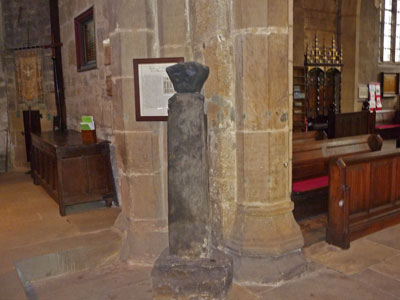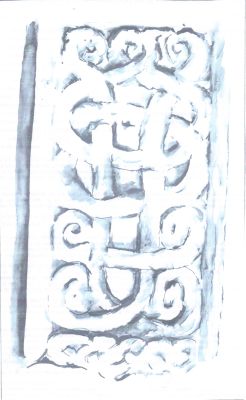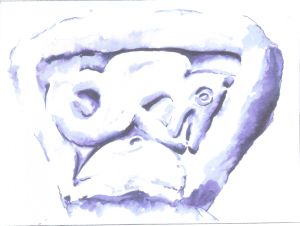by David Moseley
St. Oswald’s Church has a lengthy and fascinating history. At the back of the church, unnoticed by most visitors, lurks the oldest example of its chequered past; soot-blackened pieces of stone bearing carvings dating from long before any part of the existing church building, in fact from shortly after the time when the invading Vikings sacked the Christian city of York, in 867 A D. This is the Guiseley Cross, which has attracted the attention of antiquarian David Mosely, and what follows is an article he wrote on the history of St Oswald’s church and the Guiseley cross in particular, for Withowinde, the journal of the Anglo-Saxon Society known as the English Companions. His work is reproduced with permission.

The Guiseley Cross
Guiseley is one of those ‘ley’ settlements so prevalent in West Yorkshire. It shares its suffix along with other local towns and villages such as Keighley, Bingley, Shipley, Ilkley, Utley and Otley, suggesting that our Anglo-Saxon ancestors had a great deal of forest clearing to do before they could establish their settlements in the area. As a local man I have long been familiar with the Ilkley crosses and the ‘Ecgberht stone’ in Bingley Parish Church, but only in recent weeks have I been aware of the Guiseley cross. A chance meeting with the Rev Isobel Rathbone, Associate Priest of Guiseley with Esholt, brought the cross to my attention and access to view the item was kindly provided to me on August 25th. I was surprised and impressed by what I saw.
The purpose of Anglo-Saxon crosses
Anglo-Saxon crosses and cross fragments are quite well represented in the Yorkshire area and many have a Scandinavian flavour, reflecting local settlement patterns in the late ninth and early tenth centuries. The Guiseley cross is one such. Often termed ‘preaching crosses’, they appear to have had several purposes. Sir Frank Stenton points out that Archbishop Theodore of Canterbury (668-690) allowed priests to say mass ‘in the field’ and that in his Book of Canons. Theodore sets out rules whereby ‘when a church has been moved to another place a cross should be erected on the site of the vanished altar’. The best evidence for a ‘preaching cross’ comes from an Anglo-Saxon nun of the eighth century. Again, I quote from Stenton’s ‘Anglo-Saxon England’: A century later (i.e. later than Theodore) the life of St. Willibald, written by a nun of West Saxon origin, represents it as an English custom that on the estates of many lords there was no church but only a cross raised on high for the daily service of prayer. Crosses were also used as memorials to individuals. We have examples in Lilla’s cross (the minster of King Eadwin, who gave his life protecting the King), the Durham Cross (for Acca, Bishop of Hexham), and the Bewcastle Cross, which may commemorate King Aldfrith the Learned of Northumbria. The Guiseley Cross, as will be seen, seems to fall into this category. Crosses also seem to have been used as boundary markers or grave markers. Some appear near religious sites but are not an integral part of them. Perhaps these mark the site of earlier altars in more primitive structures prior to the main church buildings as already discussed. Stenton described the eighth century crosses of Mercia and Northumbria as ‘sculpture of a quality unapproached elsewhere in Europe’, but he adds that – with certain exceptions – they were generally more successful in design than in the representation of the human figure. The vine-scroll was a very popular motif. The Guiseley cross features the triquetra, a design of three interfacing eye-shapes, which also features on some Northumbrian coins.
The Guiseley Evidence – Church and Village
Guiseley has its roots in Anglo-Saxon England. The name means Gislica’s clearing. Ekwall in his Dictionary of English Placenames suggests that since ‘Gislica is a normal hypocristic form of names in Gisl-‘ then this modern name ‘may well show Scandinavian influence.’ This would fit well with the evidence of the cross. Elwall gives 972 as the first year in which Guiseley is mentioned. This would be during the reign of King Eadgar the Peaceful (959-975) who showed favour to England’s Danish settlers and was respected by them in return. It was also the year in which Archbishop Oswald of York took office. He held his tenure for 20 years and is prominent in the Guiseley story. Indeed, the 1964 guidebook tends to suggest that he is the Oswald featured in the church dedication, albeit that two splendid stained glass windows in the church feature the more famous St Oswald, King of Northumbria 634-642. A commemorative custom is enacted at the church on 5 August, St Oswald’s Day (the day the king fell at the battle of Maserfield). The congregation perform the ‘clipping ceremony’, whereby parishioners of all ages form a circle round the church and thrice invoke the blessing ‘God bless our church’. It seem likely that the name of this ceremony comes from an Old English word, either ‘cleopan’ (to embrace/cleave to)’ or clipian’ (to summon/call).
From the outside the church appears to be a Victorian structure but once inside it is obvious that the south aisle columns are Norman. Usually the oldest surviving part of such structures is the crypt but unfortunately this was not available for inspection at the time of my visit. Interesting as the church was, I do not feel, having weighed the evidence, that I can claim that an Anglo-Saxon church once stood here. Any emergent subsequent evidence could cause me to change my mind in this regard.
The cross has a place of honour at the west end. It stands about six feet tall, consisting mainly of a decorated shaft in a plain rough hewn base. A cross arm has been cemented to the top of the shaft. Behind it is an extract from the work of Professor W G Collingwood from 1914, complete with helpful elevations. The first thing I noticed was that Collingwood had three stones to examine but only two are now on show.
Details of Guiseley Cross
The Cross-arm and Cross-shaft
Only one arm of a four-armed cross survives. It was part of a free-standing cross, and not a cross in a circle. It did not form the bottom arm of the cross, which would have been attached to the top of the shaft. Although the decoration of the cross-shaft could fit well with the shaft, no proof exists that the shaft and the arm were part of the same cross. The 1964 guidebook refers to the fragments “belonging to three crosses”. Ilkley church boasts three crosses from about 800. Collingwood took the view that the shaft and the arm could be from the same cross but that the third fragment (of which more later) was from a different cross.
The arm has been cemented to the top of the shaft in such a way as to give it the appearance of a stone fan. The cross is displayed in such a way as to make the “back” very hard to see and most of my comments on that area rely on Collingwood’s drawings. He describes the hidden decoration as a “double-strand triquetra plait”. The “front” of the arm is very striking as I believe the dragon-headed snake depicted with its tail in its mouth represents the Midgard Serpent, also known as the “World Serpent” or the “Serpent Dragon”.
The Midgard Serpent famously encircles the earth from the great primeval sea surrounding it. Thor (the Anglo-Saxon Thunor), having caught the beast on his fishing-line, attempts to despatch it with his hammer but the giant Hymir releases it by cutting the kine. Although Thor is eventually successful and kills the beast, its malodorous breath also kills him.
Thor and his battle with the Midgard Serpent is a favourite theme of northern crosses. It features on Cumbria’s elegant Gosforth cross and on the Marton cross fragments in Yorkshire’s Craven district. The fragment at East Riddlesden Hall near Keighley (home of the Gospatric family featured in the Chronicles) shows the pelican “vulning” (pecking its breast to feed its young with its own blood) as a representtion of Christ. The bird however rests on a “T”-shaped object which could be Thor’s hammer.
In terms of the half-circle below the serpent I have no explanation to offer. The description with the cross is based heavily on Collingwood’s work but makes the occasional mistake and in terms of the half-circle adds an extra comment which I find rather unhelpful. It states that this section has “almost the look of the upper part of a face…but it isn’t”. The cross-arm is clearly arranged to show the strongest decoration against the strongest shaft decoration, although in trying to reconstruct the cross-head Colligwood saw links between the “back” of the cross-arm and the “front” of the shaft. I can see what he is getting at but I am not entirely convinced.
Phrases such as the “front” and the “back” of course relate only to the manner in which the cross is currently displayed. What was the “front” or the “back” originally or indeed whether or not both sides carried equal importance it is impossible to say. The cross-arm edges carry no decoration.


As with the cross-head, I could not see all four sides of the shaft due to its positioning in the church. Collingwood labelled the four sides of the shaft “C” (broad face at the “back”), “D” (side to the left of the shaft as viewed from the “front”), “C” (broad face at the “front”), and “F” being the remaining side. I see no need to Ite this allocation.Side C was rather worn and chiselled away when Collingwood inspected it in 1914 and even lets is visible today. Although it was very difficult to see, I could see, I could see enough to be aware tht the “little sword” Collingwood observed had gone. He described it as “a Viking age sword perhaps belonging to the seated figure of a warrior”, and likened the sword to that held by a standing warrior on the Otley cross. I could not even pick out Hm “dragonesque shapes” as the top of C which Collingwood tried to link to the surviving cross-arm. This may have been because that area was in shadow.
Face E is typical Viking work. At the top is what Collingwood very .t|>tly described as a “battered triquetra”- battered almost out of recognition in fact. This is separated from the main design by a sort of chain formation The main pattern reminded me of those naive snake-like shapes I had seen in illustrations of Harald Blue-Tooth’s rune-stone at Jelling. A bold, primitive design so unlike the neater and more regularly geometric work of the famous Anglo-Saxon crosses. Collingwood sums it up as “debased scroll-work, flat and in low relief.
Face D, one of the two narrow sides, appears to me to be the finest geometric work on the stone. This is so good when compared to the other two visible sides that I have to wonder if it was chiselled by the same hand.
Collingwood describes D as exhibiting the “hacked ring-twist common to the Viking age style.” It appears to be more deeply cut than the other faces. Face F, like E, is also “flat and in low relief. Collingwood sums it up eloquently as a “debased scimitile trellis”. I was puzzled by the word “cim’rtile0 but it means “scimitar-like” according to my dictionary. The pattern is like interlaced scimitars. The shaft decoration stops at about 40 per cent above the junction of shaft and base. This is not unusual. The Gosforth cross decoration also stops short of the base. Some early Anglo-Saxon crosses were completely undecorated.
The Third Stone
Collingwood splits the Guiseley cross into three sections. The shaft and base he linke together as one piece. The cross-arm he records as one piece and the lost stone is his third piece. Looking at Coliingwood’s drawings, I at first tried to tie this stone in as another bit of the free-armed cross but this doesn’t work.
Collingwood describes it as a part of “a cross-shaft” rather than “the cross-shaft” but is of the view, which I share, that this represented an altogether separate cross. This may be why, over the years, it ceased to be on display. An examination of the objects placed in the crypt may lead to its rediscovery one day. Collingwood describes it as “too damaged to restore”. The missing piece, unlike the piece in the church , does depict part of a human figure. The figure i sonly preserved from the chest down and wears a loose garment which stops short to reveal part of the legs and feet from below the knee. An arm and hand hang down the right side of the figure (as viewed from the front) which seem out of proportion to the body. The hand appears to be denched round some object – perhaps a stone. Beneath the figure is a further crudely-executed tangled serpent with a dragon head and its tail in its mouth. I considered the idea of Thor and the Midgard serpent but I suspect even the most primitive of sculptors would produce a more recognisable version of Thor”s hammer than is shown here. Collingwood ventured the suggestion that it could be Christ bruising the head of the serpent. If so, it represents the only bit of overtly Christian design on the three stones. No doubt this suggestion went down well with the clergy of 1914, however I have considerable doubts about this. The human figure is above the serpent’s nose in the design but not standing on its head. Since Christ bruised the serpent’s head with his heel, why is he carrying a large stone to do the job? We need the rest of the figure to make a judgement of this depiction. On the basis of what we have I do not believe this to be a Christian scene.
Collingwood describes the other decoration on the stone as “flat-strapped plait”. At least one triquetra may also be present